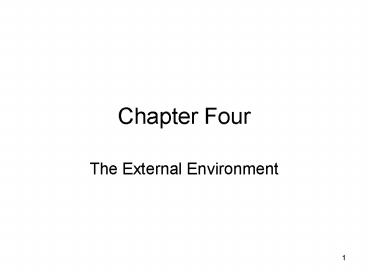Chapter Four - PowerPoint PPT Presentation
1 / 15
Title:
Chapter Four
Description:
Small number of external elements and elements are similar ... Institutionalism. Population. Ecology. Organization Type. Organization. Relationship. Dissimilar ... – PowerPoint PPT presentation
Number of Views:47
Avg rating:3.0/5.0
Title: Chapter Four
1
Chapter Four
- The External Environment
2
An Organizations Environment
- (a) Competitors, industry size and
- competitiveness, related issues
- (b) Suppliers,
- manufacturers, real
- estate, services
- (c) Labor market,
- employment agencies,
- universities, training
- schools, employees
- in other companies,
- unionization
- (d) Stock markets,
- banks, savings and
- loans, private
- investors
- (e) Customers, clients,
- potential users of products
- and services
- (f) Techniques of production, science,
(g) Recession, unemployment rate, inflation rate,
rate of investment, economics, growth (h) City,
state, federal laws and regulations,
taxes, services, court system, political
processes (i) Age, values, beliefs, education,
religion, work ethic, consumer and
green movements (j) Competition from and
acquisition by foreign firms, entry into
overseas markets, foreign customs,
regulations, exchange rates
International Context
(j) International Sector
(a) Industry Sector
(i) Sociocultural Sector
(b) Raw Materials Sector
DOMAIN
(c) Human Resources Sector
(h) Government Sector
ORGANIZATION
(d) Financial Resources Sector
(g) Economic Conditions Sector
(e) Market Sector
(f) Technology Sector
3
Framework for Assessing Environmental Uncertainty
STABLE
Uncertainty
ENVIRONMENTAL CHANGE
UNSTABLE
SIMPLE
COMPLEX
ENVIRONMENTAL COMPLEXITY
4
Organizational Departments Differentiate to Meet
Needs ofSub-environments
President
R D Division
Sales Division
Manufacturing Division
5
Differences in Goals and Orientations Among
Organizational Departments
Characteristic R D Department Manufacturing Department Sales Department
Goals New developments, quality Efficient production Customer satisfaction
Time Horizon Long Short Short
Interpersonal Orientation Mostly task Task Social
Formality of Structure Low High High
Source Based on Paul R. Lawrence and Jay W.
Lorsch, Organization and Environment (Homewood,
Ill. Irwin, 1969), pp. 23-29.
6
Environmental Uncertainty and Organizational
Integrators
Industry Plastics Foods Container
Environmental Uncertainty High Moderate Low
Departmental Differentiation High Moderate Low
Percent of management in integrating roles 22 17 0
Source Based on Jay W. Lorsch and Paul R.
Lawrence, Environmental Factors and
Organizational Integration, Organization
Planning Cases and Concepts (Homewood,
Ill. Irwin and Dorsey, 1972), 45.
7
Forms Mechanistic Organic
- Tasks are broken down into specialized, separate
parts. - Tasks are rigidly defined.
- There is a strict hierarchy of authority and
control, and there are many rules. - Knowledge and control of tasks are centralized at
the top of the organization. - Communication is vertical.
- Employees contribute to the common task of the
department. - Tasks are adjusted and redefined through
teamwork. - There is less hierarchy of authority and control,
and there are few rules. - Knowledge and control of tasks are located
anywhere in the organization. - Communication is horizontal.
Source Adapted from Gerald Zaltman, Robert
Duncan, and Jonny Holbek, Innovations and
Organizations (New York Wiley, 1973), 131.
8
Contingency Framework for Environmental
Uncertainty and Organizational Responses
STABLE
ENVIRONMENTAL CHANGE
Uncertainty
UNSTABLE
SIMPLE
COMPLEX
ENVIRONMENTAL COMPLEXITY
9
Organization Strategies for Controlling the
External Environment
- Controlling the Environmental Domain
- Change of domain
- Political activity, regulation
- Trade associations
- Illegitimate activities
- Establishing Interorganizational Linkages
- Ownership
- Contracts, joint ventures
- Cooptation, interlocking directorates
- Executive recruitment
- Advertising, public relations
10
Relationship Between Environmental
Characteristics and Organizational Actions
Environment
Organization
Many departments and boundary roles Greater
differentiation and more integrators for
internal coordination
High complexity
High uncertainty
Organic structure and systems with low
formalization, decentralization, and low
standardization to enable a high-speed response
High rate of change
Environmental domain (ten sectors)
Establishment of favorable linkages ownership,
strategic alliances, cooptations, interlocking
directorates, executive recruitment,
advertising, and public relations
Resource dependence
Scarcity of valued resources
Control of the environmental domain change of
domain, political activity, regulation, trade
associations, and illegitimate activities
11
Chapter Five
- Interorganizational Relationships
12
A Framework of Interorganizational Relationships
Thanks to Anand Narasimhan for suggesting this
framework.
13
Changing Characteristics of Interorganizational
Relationships
Traditional Orientation Adversarial
New Orientation Partnership
Trust, addition of value to both sides, high
commitment Equity, fair dealing, both
profit Electronic linkages to share key
information, problem feedback and
discussion Mechanisms for close coordination,
people on-site Involvement in partners product
design and production, shared resources Long-term
contracts Business assistance beyond the
contract
Suspicion, competition, arms length Price,
efficiency, own profits Limited information and
feedback Legal resolution of conflict Minimal
involvement and up-front investment, separate
resources Short-term contracts Contract
limiting the relationship
14
Elements in the Population Ecology Model of
Organizations
15
Three Mechanisms for Institutional Adaptation
Normative
Coercive
Mimetic
Duty, obligation
Dependence
Uncertainty
Reasons to become similar
Professionalismcertification, accreditation
Political law, rules, sanctions
Innovation visibility
Events
Moral
Legal
Culturally supported
Social basis
Example
Accounting standards, consultant training
Pollution controls, school regulations
Reengineering, benchmarking
Source Adapted from W. Richard
Scott, Institutions and Organizations (Thousand
Oaks, Calif. Sage, 1995).

